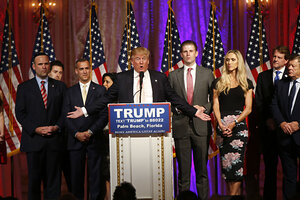Trump just won big. He still faces contested convention.
Do the math, and it remains quite possible that Trump could continue to march along, yet fall short of the 1,237 delegates needed to win the nomination outright.

Republican presidential candidate Donald Trump speaks to supporters at his primary election night event at his Mar-a-Lago Club in Palm Beach, Fla., Tuesday, March 15, 2016.
Gerald Herbert/AP
Will Donald Trump be able to avoid a contested Republican National Convention in Cleveland in July?
He might not, despite his sweeping victories in the big primaries of March 15. Gov. John Kasich won Ohio, denying Trump the state’s crucial 66 delegates. Do the math, and it remains quite possible that Trump could continue to march along, yet fall short of the 1,237 delegates needed to win the nomination outright.
As of March 16 Trump has won 699 Republican delegates. That’s about 47 percent of the delegates awarded so far.
You’ll notice that’s less than majority. That means he’ll have to win more than half of the remaining delegates to get to Cleveland with a winning 50 percent plus one on his side. He’ll have to win 54 percent, to be precise. With 19 states still to go, Trump may well hit that number. Marco Rubio’s exit means he has fewer competitors. But it’s still a three-way race, meaning Trump is running against the votes accumulated by two competitors. Kasich and Ted Cruz could well suck up just enough delegates to keep Trump from the nomination mountaintop.
“Most observers appear to think that the Republicans are headed for a contested convention now, because with Kasich’s win in Ohio, Donald Trump probably cannot get to the magic number of 1,237 delegates,” write Kyle Kondik, Larry Sabato, and Geoffrey Skelley today in the University of Virginia’s Sabato’s Crystal Ball.
Enter a contested convention. Please. A convention that actually decides something – and is not a three-day infomercial for a preselected nominee – would be a once-in-a-lifetime event for journalists. It would be Woodstock without the mud, plus rental cars and free food.
Delegates are bound to vote according to the results of their state primaries or caucuses for the first ballot. Some state rules bind delegates for a round or two more. After that, it’s free play. Delegates can vote for whomever they please, including candidates who didn’t run in primary season.
Remember, this would not be an unscripted, ad hoc occurrence. The #NeverTrump forces are planning their strategy for a contested convention at this moment. Uprisings take work.
Sasha Issenberg has a timeline for contested convention planning up today at Bloomberg View. In March, the anti-Trump cabal will be looking for “double agents,” Mr. Issenberg writes – delegates bound to Trump who personally oppose him. Once set free, they would run to vote for someone else.
In April and May, the cabal will deal with GOP governors or other state leaders who have influence with their own delegations. They’ll troll for delegates who can be (legally) bought via payment for their convention expenses or some other enticement.
In June, if it’s clear Trump is short of a delegate majority, they’ll put pressure on the Republican Party apparatus to investigate and perhaps disqualify suspect delegations. Remember the chaos at the Nevada caucuses? Expect that to come up again.
Then in July, GOP party officials will gather in Cleveland prior to the convention’s start to establish rules and handle other committee business. They could start setting the stage for an uprising on the floor, perhaps by revisiting the RNC’s Rule 40, which sets criteria for candidates to appear on convention ballots.
“This is where the establishment has effectively unchecked power to begin squeezing out a candidate it does not want to see nominated,” Issenberg writes.
Would this be fair? Trump supporters might say something more pungent than simply “no.” Their reply could create chaos and possibly rip the party apart.
Trump commands a hard core of around 35 percent of GOP voters nationally; many of them might stay home if their man is replaced. And Trump almost certainly will emerge from the primaries with the most state victories and the most delegates, by far. Why should someone he’s already defeated replace him? Or worse, why should someone who never ran at all get the top prize?
One reason why: It’s happened before. For some 160 years, the GOP has required that its nominees win a majority of convention delegates, writes RealClearPolitics election analyst Sean Trende. Among those who’ve lost under these rules: James Blaine, who had 45.9 percent of delegates in early rounds of 1876 convention voting; Leonard Wood, who had 45.5 percent in 1920; and Tom Dewey, who had 36.1 percent in 1940.
If it only took a plurality to win, a candidate who is really the convention’s second or third choice could emerge as the winner. That’s where the GOP could be headed this year: Trump loses one-on-one match-ups with some of his rivals, according to polls. But they’ve split the anti-Trump vote perfectly, allowing him to lead despite national support that averages out to about 36 percent of GOP ballots cast, so far.
“You can’t steal something from someone who has no legitimate claim to it, and the rules here do not give someone a legitimate claim to the nomination without a majority of the delegates. If Trump can’t get that majority to back him, he will lose, and it will be because he should,” writes Mr. Trende.

